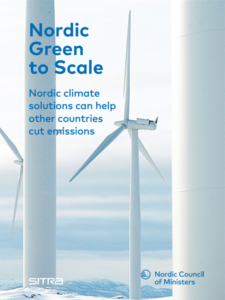 To achieve the goals set in the Paris agreement – to limit global warming to well below 2˚C and pursue efforts to keep it at just 1.5˚C – countries need to ramp up their climate efforts significantly. And we need to do it fast. That is why this study is so important. Like the global Green to Scale report released last year, this Nordic study shows that there are already plenty of proven low-carbon solutions available, and at an affordable cost.
To achieve the goals set in the Paris agreement – to limit global warming to well below 2˚C and pursue efforts to keep it at just 1.5˚C – countries need to ramp up their climate efforts significantly. And we need to do it fast. That is why this study is so important. Like the global Green to Scale report released last year, this Nordic study shows that there are already plenty of proven low-carbon solutions available, and at an affordable cost.
The Nordic Green to Scale project helps in choosing the concrete low-carbon solutions to do so. The study looks at 15 existing climate solutions that have been proven to work in the Nordic region and the climate impact and costs of scaling them up to other countries have been estimated. The report also looks at co-benefits of and barriers to these solutions, as well as policies to promote them.
The low-carbon solutions were selected mainly based on four criteria: 1) Nordic distinctiveness, 2) proven climate impact, 3) analysis feasibility, and 4) scalability. The project also strived to maintain a reasonable geographical and sectoral balance. Many more Nordic solutions already exist that could contribute to reducing global emissions. There are still more solutions that are currently being developed or in the early stages of implementation.
The Green to Scale project focuses on a selection of existing solutions only. To qualify, a solution must have a proven track record of being implemented at significant scale for some time. This and other studies show that simply using what we already have can take us a long way in tackling the climate crisis. However, various emerging solutions are likely to make reducing emissions easier, cheaper and faster.
- Energy. In Norway, Statoil has piloted floating wind farms. In Finland, a demonstration project called DeepHeat plans to use the geothermal energy buried kilometres underground for heating the city of Espoo. Denmark is integrating largescale solar collectors to district heating systems.
- Industry. Apart from oil and gas production, Norway has built carbon capture and storage facilities also in the production of fertilisers and cement as well as waste incineration. Iceland already captures CO2 and stores it in basaltic rock. The Swedish metal processing industry invests in research and development for radical innovations to reduce process emissions.
- Transport. Sweden is piloting electric highways that would allow trucks to switch to electricity. Finnish company Neste is providing biofuels for aeroplanes and other companies are producing advanced biofuels out of cellulosic residues. Norway has introduced electric ferries.
- Buildings and households. Many Nordic countries have examples of net-zero houses – or even buildings that produce more energy than they consume. Smart homes let people monitor and control their energy use better, simultaneously saving energy.
- Agriculture and forests. Several Swedish and Finnish companies are producing plant-based alternatives to more carbon-intensive meat and dairy products. A Norwegian project is piloting the production of ocean biomass and at the same time storing carbon.
These and many other examples illustrate the wide range of activity on low-carbon innovation in the Nordic countries. If we were to replicate the Green to Scale analysis in 5–10 years, some of the emerging solutions might have become proven, making it again easier to reduce emissions.
Scaling up the selected Nordic solutions can cut global emissions by 4.1 gigatonnes (GtCO2e) in 2030. The reduction is equal to the current total emissions of the European Union. The climate impact varies greatly between solutions. The solution with the largest potential is combined heat and power production, which alone could reduce emissions by almost as much as Japan produces every year.
This study shows that simply using what we already have can take us a long way in tackling the climate crisis, building on the Nordic experience. Countries around the world have a range of proven and attractive low-carbon solutions to choose from.
Read more